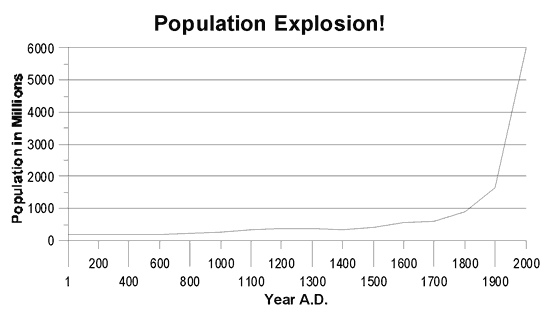Earth's Carrying Capacity
Earth's basic carrying capacity refers to the greatest
number of living species (including humans) that can be supported
in an area given its environmental conditions. For example, to
raise one cow requires one acre of rich pastureland or ten acres
of scrub-land. Earth's human biophysical carrying capacity
is the maximum human population size that the Earth can support in
the long term using our technological capabilities, without
degrading the environment.
Overpopulation occurs when people (or organisms) become so
numerous that they degrade the ability of the environment to
support their kind in the future. Symptoms of human overpopulation
include such things as when soil is allowed to erode faster than
new soil can be generated, draining aquifers faster than they can
be recharged, or exterminating populations and species that are
working parts of the ecosystems that support agriculture and
fisheries. At the present time no nation on earth is supporting
its present population on its own sustainable flow of renewable
resources.
Demographic Momentum
In the United States there is a feeling that the population growth
problem under control, since our fertility rate
(the average number of
children born to a woman in her lifetime) has decreased to 2.1.
However, zero population growth can only be achieved when
the percentage of elderly people is equal to the percentage at
child bearing age, and even when that equilibrium occurs, it will
take another 60 - 70 years for the population to stabilize, during
which time the population will still continue to increase.
Demographic momentum
is the term used to describe this tendency of a previously growing
population to keep expanding long after reproductive rates have
been reduced.
In the United States population will stabilize only when the
numbers of births plus immigrants equals the number of deaths plus
emigrants. It is not clear when, or even if, that will occur.
Currently at 275 million, the United States is the third most
populous country in the world and is growing by more than 2.5
million people each year. According to modest projections by the
U.S. Bureau of the Census, the U.S. population could grow by 130
million Americans by 2050.

Population Timeline
|
Year
|
Event
|
World Population
|
|
10,000 BC |
End of the last Ice Age; humans lived as hunters and gatherers |
4,000,000
|
|
8000 |
Agricultural Revolution; domestication of plants and animals |
4,500,000
|
|
3000 |
Bronze Age begins; use of weapons and sailing ships |
14,000,000
|
|
1500 |
Iron Age begins |
38,000,000
|
|
1 AD
|
Farmed land is producing 50 times more than unfarmed land |
170,000,000
|
|
700 |
Population explosion in China, first large urban developments |
210,000,000
|
|
1233 |
Coal mined in Newcastle, England |
360,000,000
|
|
1400 |
Bubonic Plague; in a period of about five years, one-fifth of
the world's population (75 million) people are lost to this
disease. |
350,000,000
|
|
1492 |
Europeans discover Americas |
425,000,000
|
|
1750 |
Industrial Revolution begins in Europe |
760,000,000
|
|
1800 |
Beginning of the Industrial Revolution in the United States |
900,000,000
|
|
1830 |
Advances in food production, water supply, sanitation,
transportation and disease control results in population
expansion |
1,000,000,000
|
|
1930 |
Despite loses from World War I, population passes 2 billion |
2,000,000,000
|
|
1960 |
Medical advances contribute to population surpassing 3 billion |
3,000,000,000
|
|
1975 |
Population Explosion! |
4,000,000,000
|
|
1987 |
|
5,000,000,000
|
|
1999 |
|
6,000,000,000
|
Resources
Demographic, Environmental & Security Issues Project -
Animated map of world population, 1 A.D. to 2020 A.D.
Facing the Future
Organization - Population Matters; site covers historical
context of population growth, as well as environmental impact.
Teacher materials available to download.
Museum of Natural
History, France - Dozens of interactive questions covering
population figures, fertility & death rates, and environmental
resources, as well as a current population counter.
Population Action
International - Student friendly site includes maps of major
resource distribution.
Population Reference Bureau -
Includes current reports, news and census data.
PBS - Paul
Erlich and the Population Bomb - Site describes the current
population growth problem.
World Book - People and the Planet - Discusses population
growth and its effect on our environment.
Zero Population Growth - Site
includes teacher and student resources. |